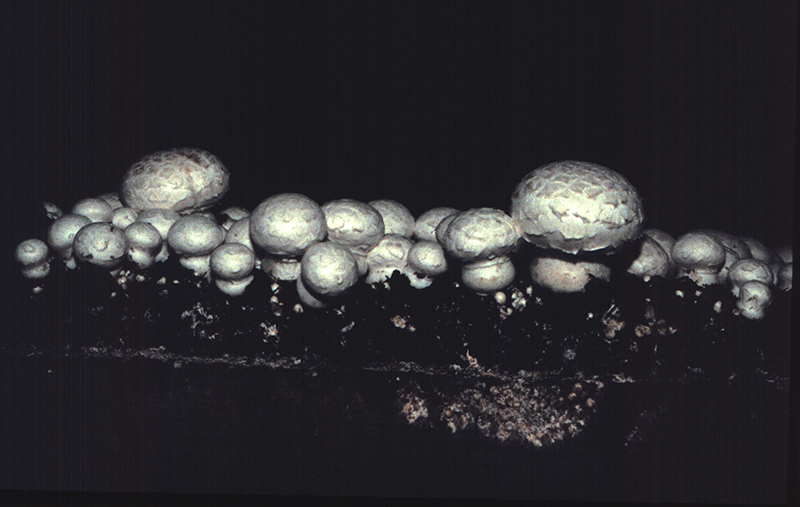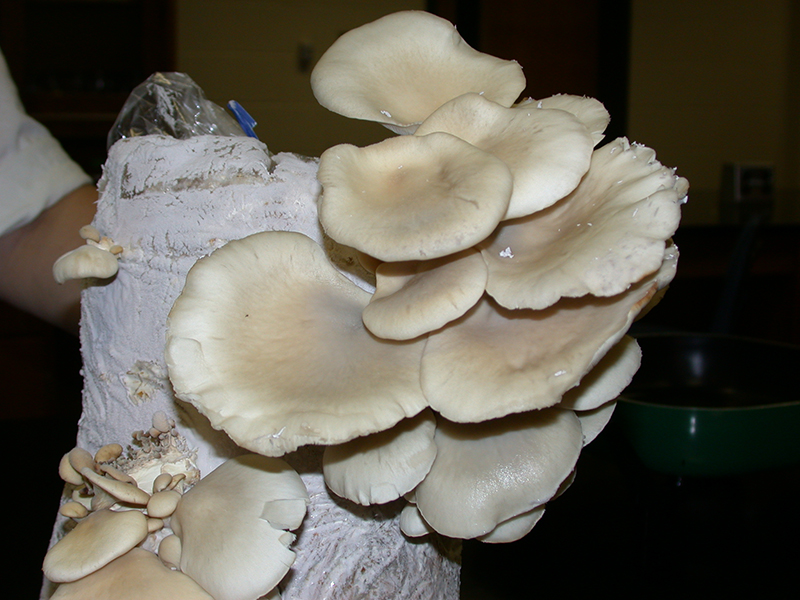Picture of the Week
February 8, 2021
Mushroom Gardening
Janna Beckerman, Ph.D., Professor & Plant Pathology Extension Specialist, Purdue University
When most people think gardening, they think of cute little green seedlings, or flowers or tomatoes. But there is another type of produce uniquely suited for winter gardening: Mushroom gardening.
Mushroom growing is a truly rewarding hobby that most people never attempt. In addition to the misconception that most fungi are poisonous, many people think it is “too hard” (wrong!) or “too weird” (no comment). Weirdness aside, today kits have been developed to easily grow edible mushrooms at home. Mushrooms can be successfully grown in the basement, bathroom or closet. And the variety of mushrooms you can grow has never been better, from the everyday grocery store mushroom (Agaricus bisporus), to Asian-cuisine favorites like Shitake (Lentinus edodes) or gourmet mushrooms such the pom-pom or bears head (Hericium uva-ursi).
If mushroom growing is so easy, then why don’t more people do it? One of the biggest mental blocks preventing people from mushroom gardening is the fact that mushrooms grow from microscopic spores, not seeds. You can’t just buy a packet of “spores” and dump them in the ground and expect mushrooms to come up! Spores must be collected in a relatively sterile environment. These spores are then used to inoculate grains, seeds or dowels to produce “spawn,” the vegetatively growing fungal tissue scientists call mycelia.
Spawn is the seed to a mushroom grower!
The spawn is then used to inoculate a specific type of substrate, depending on the type of mushroom you are growing. Like plants, different mushrooms require different growing conditions. However, unlike most plants, mushrooms have no chlorophyll, and are required to get all their nutrients from whatever organic matter is in their growing medium. This makes what you are growing them in extremely important! Depending on the type of mushroom you are growing, the substrate or compost is composed of various materials such as corncobs, cottonseed, sawdust, straw, logs, gypsum and nitrogen supplements. The substrate is sterilized and then the spawn is worked into the compost, or the spawn-covered dowel is inoculated into the logs.
Over time, the mycelia grow throughout the substrate. Getting the mycelia to fruit requires as little as watering (for the white button mushroom) to submerging the "log" or "block" (either a real log or a bag inoculated with shiitake or other type of fungus) in cold water for 24 to 48 hours. Fruiting can take from 2 weeks to 2 months. Size is no indication of maturity in mushrooms. Ripe mushrooms vary from small buttons to large caps. Crops are harvested over a period of several weeks to even several months.
Mushroom gardening is so simple that it can be summarized into three easy steps:
1) Acquiring spawn
2) Inoculating (introducing) the spawn to the compost or substrate it is to grow on. This could be a box of compost, a bag of sterilized sawdust, or even a log!
3) Getting the fungus to produce mushrooms.
They are two main ways you can go about mushroom growing: kits, which have everything ready for you, just add water (kits allow you to start at step two or three); or buying the starter culture (referred to as 'spawn') and getting the mushroom growing substrate yourself or purchasing it separately. As you can imagine, kits are the more expensive route to go, but is recommended for the novice, the fearful or the forgetful people who can't remember to water things on a regular basis(you know who you are)! For first time mushroom growers, kits are the way to go!
One of the easiest mushrooms for beginners is the common grocery store mushroom, Agaricus bisporus. Kits consist of a box with spawn, casing (usually sphagnum moss which is placed on top to keep the compost moist) and compost. After the casing is moistened, the only care required is a daily misting to keep the casing moist. After the mycelia has covered much of the compost, the box can be briefly chilled or just plain left alone to initiate the development of the mushrooms, which will form in 1-3 weeks. Not convinced how easy this is? More detailed instructions can be found at: http://www.mushroomadventures.com
 Button mushrooms
(Agaricus)
Button mushrooms
(Agaricus) For the more gastronomically daring, here are a few other varieties of mushrooms to consider:
Oyster mushroom (Pleurotus spp.):
Kits often consist of a bag containing a mycelial-covered block. The bag is watered thoroughly and then tented, which consists of placing skewers or dowels in such a way to prevent the bag from touching the block. Remember, fungi are alive and need to “breathe.” A fluorescent light or daylight (but not direct sunlight) will encourage fruiting. Small bumps, or what mushroom farmers call “pins"
should start to push through the casing layer in 1-2 weeks. As mushrooms start to form, continue misting lightly. Over misting will cause them to rot. Continue with this misting procedure until the mushrooms are ready to pick. After the first crop, begin misting process again. The mycelium will digest more compost as it readies itself for the next "flush" of mushrooms. This mushroom (some species actually do have a taste reminiscent of oysters) is delicious either fried or grilled.
 Oyster mushrooms
(Pleurotus)
Pictures courtesy of Martin Huss
Oyster mushrooms
(Pleurotus)
Pictures courtesy of Martin Huss Shitake mushroom (Lentinus edodes):
Like the oyster mushroom, kits are usually sent as a mycelial-covered block in a sterile bag. The block remains in the bag and is "tented," covered to keep dust and other spores from landing on it, but allowing airflow necessary for fruiting to occur by inserting dowels to prevent the bag from sticking to the block. Some kits only require that you slash open the bags. At this point, the blocks need to be misted several times a day to prevent the mycelia from drying out. The mushrooms emerge from the cut holes and grow until harvesting. Usually, 2-3 additional harvests can be "coaxed" out of the block before it is ready for your own compost pile. This mushroom is used in hearty soups (think beef-barley) and stir-fries.
For more information on where to purchase kits, mushroom hunting, identification and culture, go to: https://fungi.com/products/growing-gourmet-and-medicinal-mushrooms
Happy Growing!

